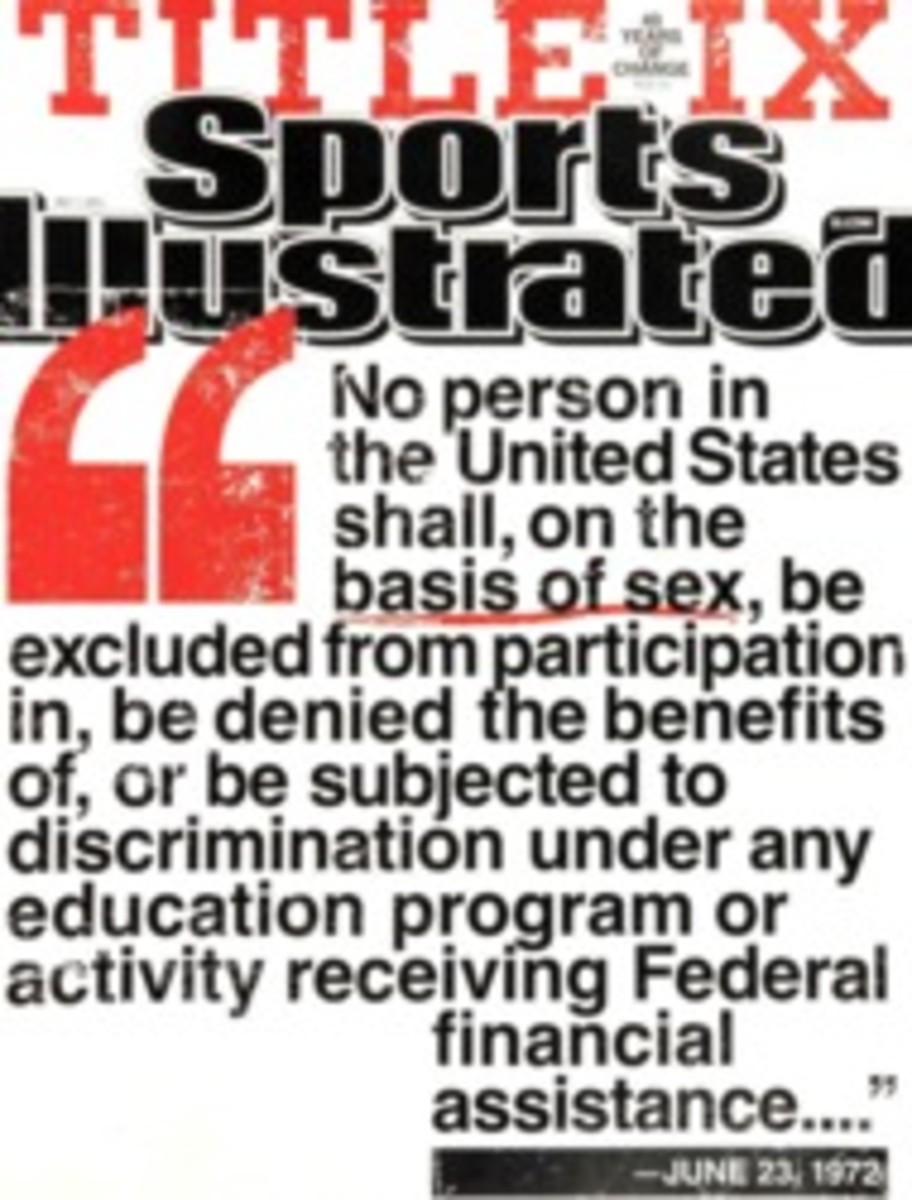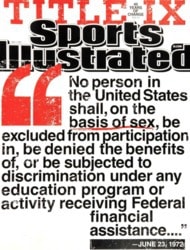
TITLE IX TIMELINE
OCT. 13, 1967:
President Johnson signs Executive Order 11375, which prohibits federal contractors from employment practices that discriminate on the basis of sex, laying the groundwork for future gender-equity legislation.
JUNE 23, 1972:
President Nixon signs into law Title IX of the Education Amendments Act, which prohibits discrimination on the basis of sex for all educational programs or activities that receive funding from the federal government. The law, which was designed to increase educational opportunities for women, goes into effect on July 1. Though it's now most closely associated with gender equity in sports, Title IX does not mention athletics.
MAY 20, 1974:
Texas senator John Tower sponsors an amendment that would exempt revenue sports from Title IX compliance. The Tower Amendment fails to pass in the House.
JULY 21, 1975:
The Department of Health, Education and Welfare issues regulations regarding Title IX enforcement, particularly as it applies to athletics. High schools and colleges that receive federal funds are given three years to comply.
FEB. 17, 1976:
The NCAA files a lawsuit challenging the legality of Title IX, claiming that no athletic programs receive direct federal funds. The suit is dismissed.
1979:
For the first time, women outnumber men in undergraduate enrollment at degree-granting institutions.
DEC. 11, 1979:
The Office for Civil Rights issues a policy interpretation that outlines three ways an institution can prove it is in compliance with Title IX.
1980:
In Alexander v. Yale, an appeals court establishes that sexual harassment is illegal because it is a form of sex discrimination covered by Title IX.
1981--82:
The NCAA crowns Division I national champions for the first time in women's cross-country, field hockey, volleyball, swimming, basketball, golf, gymnastics, tennis, outdoor track and softball. This hastens the dissolution of the Association of Intercollegiate Athletics for Women, which had administered championships for the previous 10 years.
1982:
Women earn more bachelor's degrees than men for the first time.
FEB. 28, 1984:
In the most significant setback for Title IX, the Supreme Court rules in Grove City College that the law applies only to the programs within an institution that receive direct federal funding, thereby excluding most athletic programs from its jurisdiction. Schools cut recently added women's teams, and the Office for Civil Rights cancels 23 investigations.
MARCH 22, 1988:
Congress overrides a veto by President Reagan and passes the Civil Rights Restoration Act, which overturns the Supreme Court's ruling in Grove City College v. Bell. The law states that any institution receiving federal funds must comply with Title IX in all its programs and activities.
NOV. 30, 1991:
The first FIFA Women's World Cup is held, in China. The U.S., which features a roster of current or former NCAA Division I players, beats Norway 2--1 in the final.
FEB. 26, 1992:
In Franklin v. Gwinnett County Public Schools, the Supreme Court holds that plaintiffs may sue for monetary damages under Title IX. After this ruling, there's a decrease in complaints to enforcement agencies over Title IX violations, and an increase in lawsuits.
1992:
The first gender equity study by the NCAA finds that while women make up 55% of undergraduate students, men constituted 70% of student-athletes and received 70% of scholarship funds, 77% of operating budgets and 83% of recruiting money. The NCAA forms the Gender-Equity Task Force.
1993:
Howard basketball coach Sanya Tyler sues the university for sex discrimination under Title IX in a D.C. superior court, saying she was paid much less than her men's counterpart. She receives the first monetary award given by a jury in a Title IX case: $2.4 million (later reduced to $1.1 million).
APRIL 16, 1993:
In Cohen v. Brown, a federal court finds that Brown University does not meet any part of the Office for Civil Rights' three-prong test: The number of male and female athletes was not substantially proportionate to their respective enrollments, there was no history of expanding participation opportunities, and Brown was not effectively accommodating the interests of female athletes. The university is ordered to reinstate the women's gymnastics and volleyball programs.
SEPT. 1, 1994:
A U.S. Court of Appeals upholds a ruling for the University of Illinois, which had terminated its men's swimming program the year before. Members of that team had sued on the grounds that they were denied equal opportunity, but this case, along with several others around this time, set a precedent that men may not use Title IX to claim sex discrimination when their programs are cut for budgetary reasons.
OCT. 20, 1994:
Congress passes the Equity in Athletics Disclosure Act, which requires federally funded coed institutions to submit annual reports about their athletics programs to better monitor Title IX compliance.
JAN. 16, 1996:
In response to growing concern that schools are cutting men's programs to reach proportionality, the Office for Civil Rights issues guidelines elaborating on the three-prong test introduced in its 1979 memo. It confirms that institutions can choose which of the three conditions they plan to meet in order to provide nondiscriminatory participation opportunities for individuals of both sexes and clarifies how Title IX requires the OCR to count those opportunities.
AUGUST 1996:
Women's soccer and softball are part of the Olympic program for the first time, at the Atlanta Games. The U.S. wins gold in both events.
DEC. 25, 2002:
New Mexico placekicker Katie Hnida is the first woman to appear in a Division I-A football game. Eight months later she becomes the first woman to score in a Division I-A game, booting a pair of PATs in a 72--8 win over Texas State-San Marcos.
JUNE 11, 2003:
A lawsuit brought against the Department of Education by the National Wrestling Coaches Association, which challenged the constitutionality of the three-prong test, is dismissed in District court largely on procedural grounds.
MARCH 17, 2005:
The Department of Education issues a policy clarification stating that schools may survey female students' interest in sports via e-mail. Institutions are allowed to equate a failure to respond with a lack of interest. Title IX supporters say this will inhibit schools from achieving greater gender equity. The Obama Administration, which emphasized civil rights enforcement on a broad range of topics, rescinded the provision in April 2010.
AUG. 3, 2011:
In a lawsuit filed in 2003 by three female wrestlers who were cut from the varsity at UC Davis, a federal court finds that the university failed to provide sufficient athletic opportunities for women. UC Davis settled with the women in February, paying more than $1.3 million to cover attorneys' fees.
APRIL 25, 2012:
Keeling Pilaro, a 13-year-old boy who was the top scorer on the girls' varsity field hockey team at Southampton (N.Y.) High last season, is told by his county's governing body for sports in Suffolk County that he can no longer play with the girls because he is too dominant, despite being smaller than most of the girls on the team. Pilaro's family has appealed the ruling.

